quantumdot
Latest
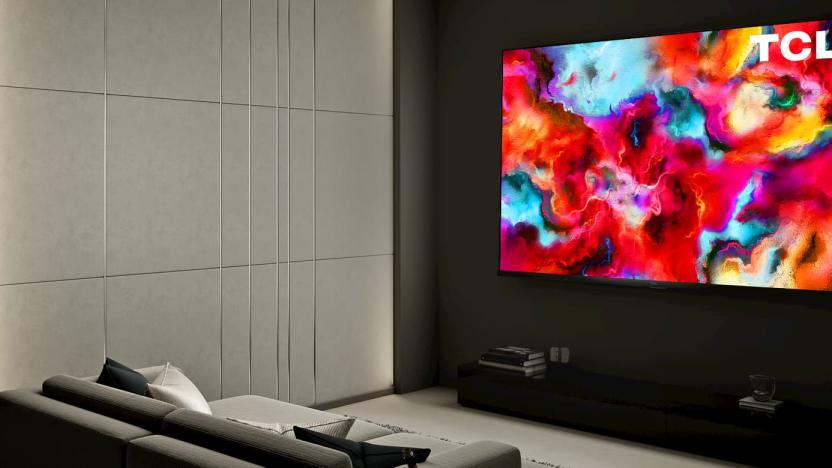
TCL opens up pre-orders for its 8-series 4K QLED TVs
Less than a month after putting its 6-series 4K QLED TVs on sale, TCL is opening up pre-orders for its 8-series displays through Best Buy. The 8-series is a newcomer to the TCL Roku TV range. Like the 6-series, it boasts boast quantum dot LED technology for better color performance, along with support for Dolby Vision, HDR10, HLG (Hybrid Log Gamma) and Dolby Atmos. It works with Google Assistant, Alexa and Roku Voice and comes with a voice remote.
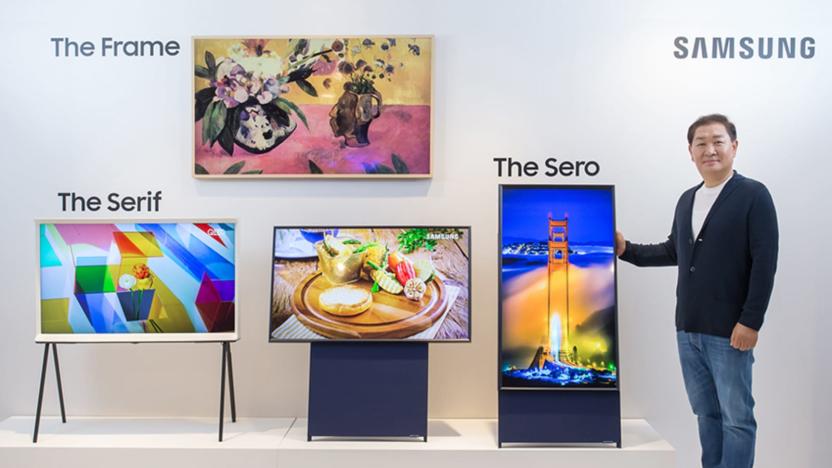
Samsung's vertical Sero TV brings Insta Stories to a big screen
Samsung has unveiled "The Sero," a 43-inch quantum-dot QLED TV with an attention-grabbing gimmick. It can be flipped around 90 degrees, letting you watch Instagram, Snap and other smartphone videos in their native vertical configurations. Samsung said it wanted to diversify its lineup and came up with the idea by studying the tastes of mobile-loving millennials. "Samsung will continue introducing screens that respect personal consumer tastes," said display president Han Jong-hee.
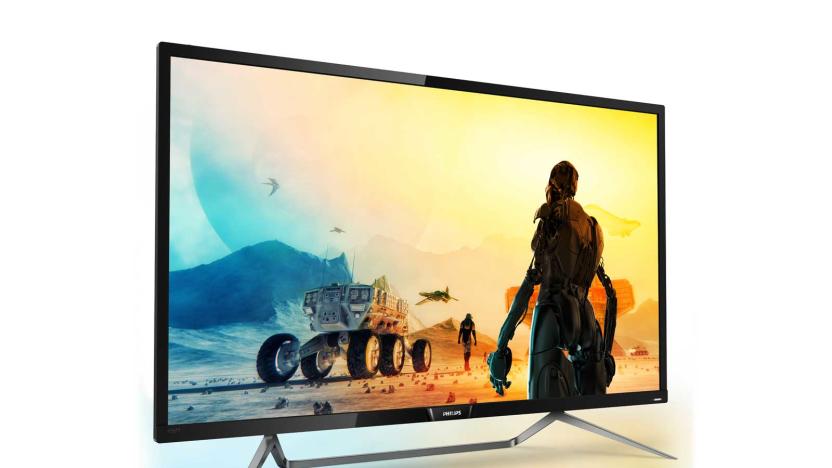
Philips' extra-bright 4K HDR monitor is now available for $1,000
If you've been salivating at the thought of Philips' (technically, EPI's) ultra-bright HDR monitor, you can now do more than clean up the mess you've left on the floor. The Momentum 43" 4K HDR Quantum Dot Monitor is now available from Amazon and Best Buy for a cool $1,000. That's a lot to pay for a computer screen, but it's also charting new ground -- this is the first PC monitor to support the DisplayHDR 1000 spec, promising 1,000cd/m2 brightness in scenes that call for it (say, staring at a bright sky) without crushing low-light detail. EPI also touts a wide, accurate color gamut that's particularly good at tackling dark reds and greens.

The first NVIDIA G-Sync HDR monitor is on sale, but it costs $1,999
NVIDIA G-Sync HDR gaming monitors promise great specs with required features like an iris-searing 1,000 nits of peak brightness, wide color gamut and high 144 Hz refresh rate. Unfortunately, G-Sync HDR monitors from the likes of ASUS and Acer have been delayed multiple times, so we've yet to learn the price or whether the displays can live up to the hype. Now, Acer's Predator X27 has gone on pre-order at Newegg, so at least we know how much it'll cost: A mind-blowing $1,999.
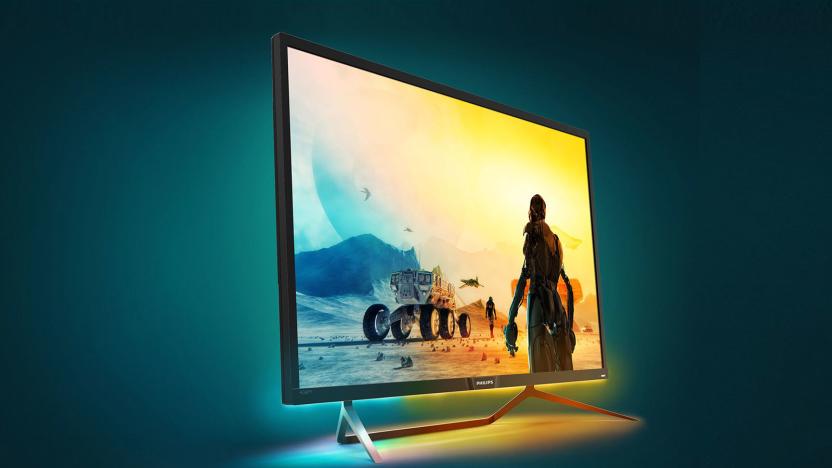
Philips' huge 4K monitor is the first with super-bright HDR
DisplayHDR certification assures consumers of an excellent standard of monitor performance, but none have received the top level -- until now. Philips' 43-inch Momentum (436M6) is the first to get HDR1000 approval, guaranteeing a superb 1,000 cd/m2 brightness, deep blacks, 10-bit color depth and an HDR-compliant color gamut. To pull it off, Philips used Quantum Dot tech, much like Samsung uses on its QLED TVs and monitors. It also features Ambiglow technology that puts a halo of light on your walls and floor, matching the content on the screen.

ASUS' new displays include one with a wireless charging pad
ASUS didn't show all its cards at its CES event. The computing giant has unveiled a pair of high-end desktop displays that each have their own clever tricks. The Designo Curve MX38VQ (above) is arguably the star if you're an everyday user: the 37.5-inch, 3,840 x 1,600 monitor packs a Qi wireless charging pad to top up your smartphone. We've seen charging before, but not on a screen this big and wide. It also packs a "frameless" panel and Harmon Kardon-boosted speakers (albeit a modest 8W) if you're tight on space.

Samsung reveals a curved, quantum dot monitor aimed at gamers
Samsung has revealed the CH711, a curved quantum dot monitor built "with gamers in mind." It also appears to be targeting Mac users and designers with the model, judging by the sharp-looking white color scheme and marketing shots (above). The displays, in 27- and 31.5-inch sizes, feature 2,560 x 1,440 resolution, a pronounced 1,800R curvature, 178-degree viewing angle and 125 percent of sRGB coverage. Cables are hidden in the stand, which also lets you flip the monitor to a vertical position, though the heavy curve might make that format a bit awkward.

Samsung TVs now play YouTube videos in HDR
If you have a recent Samsung TV and want more high dynamic range content without having to buy a game console, you're in luck. Samsung's 2016 quantum dot and 4K TVs are getting support for HDR YouTube videos thanks to an updated YouTube app rolling out to sets worldwide starting in December. You now only have to visit a special HDR section in the software to find a library of extra-vivid videos -- no subscription services or dedicated media devices required. There's still going to be a relatively limited selection of clips given how new HDR is for YouTube as a whole, but it's an important step for making the color-rich technology available to a wider audience... and, of course, it's a good excuse to show off your new TV.

Samsung guarantees its latest SUHD TVs won't suffer burn-in
If the constant fear of screen burn-in was keeping you from making a big television purchase, then Samsung's new guarantee might make you reconsider. The electronics giant announced today that it is providing a lifetime guarantee against the dreaded screen burn-in for all of its 2016 SUHD Quantum Dot TVs. Should your brand-new, ultra high-def, HDR+ set suffer burn-in (from "normal consumer use," of course) Samsung will replace it for free.
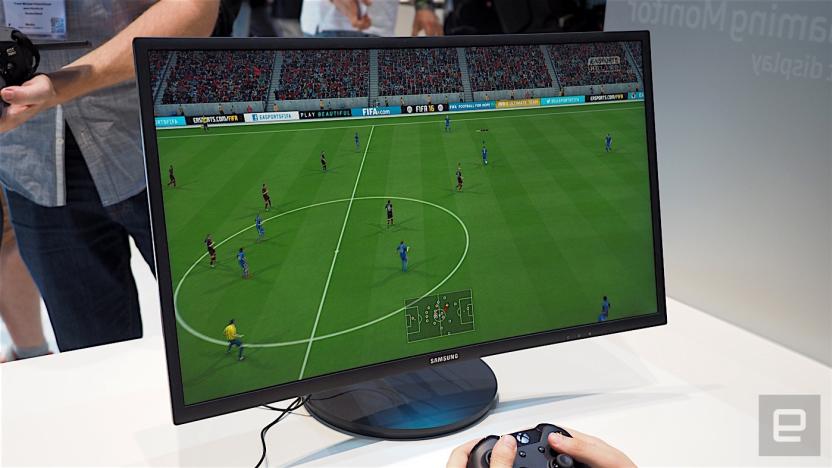
Samsung brings quantum dots to its curved gaming monitors
Samsung has announced a trio of high-end curved gaming monitors that brings its quantum dot technology to the masses. There are two devices, the CFG70, which is available in 24-and-27-inch sizes, as well as a super premium CF791 that packs a 34-inch, 3,440 x 1,400 display. The devices promise to create more immersive gaming experiences that look as good as they possibly could, although we couldn't tell that from the demo. Unfortunately, a leisurely game of FIFA Soccer is the worst way to show off a monitor that's really designed for fast-paced games like first-person shooters

Samsung HDR update improves the color in its high-end TVs
Samsung is rolling out a firmware update for its 2016 lineup of quantum dot SUHD TVs that adds an "HDR+" setting, giving them more and brighter colors, deeper blacks and improved contrast. It significantly enhances HDR content from providers like Netflix, Amazon and YouTube, and will also improve regular, standard dynamic range video. The result is punchier images and highly granular control for experts, according to Samsung.
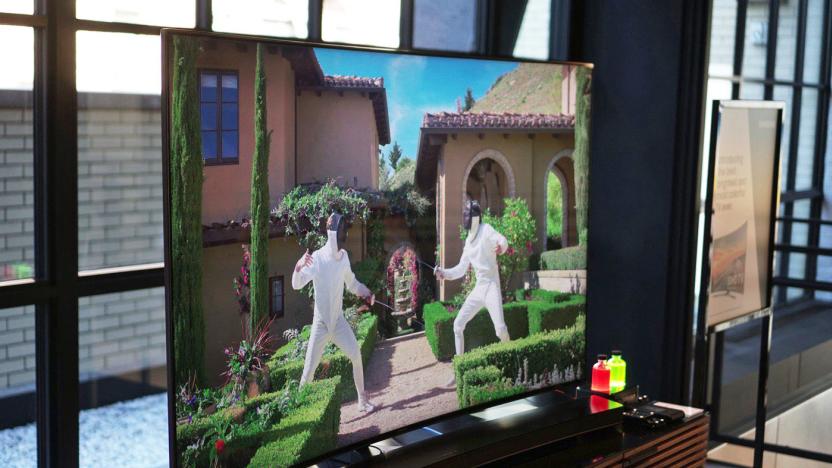
Samsung's 2016 4K TVs start at $1,499, get even smarter
This year is shaping up to be a 4K HDR showdown for all of the big TV makers. We've already seen Vizio and LG's entries, and now Samsung has announced more details about its latest lineup. All of its new 4K TVs feature quantum dot technology, which promise more accurate colors compared to LED on its own. They also sport a revamped "Smart Hub" interface, which streamlines the entire process of setting up your TV and integrating new devices. And, as we've heard before, they'll also serve as hubs for Samsung's SmartThings IoT platform, allowing you to control a variety of smart home devices using the TV.

Light-triggered nanoparticles kill drug-resistant bacteria
Many current attempts at killing drug-resistant "superbugs" amount to racing against time, whether it's improving research technology or developing germ-fighting techniques that are less likely to promote resistance. That's not really an effective long-term strategy, is it? However, University of Colorado scientists might have a more permanent solution. They've developed light-triggered nanoparticles (specifically, quantum dots) that can kill stubborn bacteria on demand. They're dormant when it's dark, but shining the right light wavelength will make the particles attack infected cells. And unlike metal nanoparticles, they won't inadvertently wreck healthy cells in the process.

Samsung's SUHD TVs amp up the colors and picture quality
Samsung hasn't gone all-in on OLED TVs like LG did this year, but it still has models that can make your wallet light in a hurry. The company just launched its latest top-shelf SUHD lineup that includes nearly every imaginable feature for those willing to pay. The main selling point is still the picture quality. While its LED quantum dot screens are arguably inferior to OLED, they're getting pretty darn close and cost less. Samsung said all of its 2016 models will get 10-bit, HDR displays with 1,000 nits of contrast between light and dark images. It's also using new tech it calls Ultra Black that "absorbs natural light the same way [as] a moth's eye" does, providing deeper blacks with less glare.
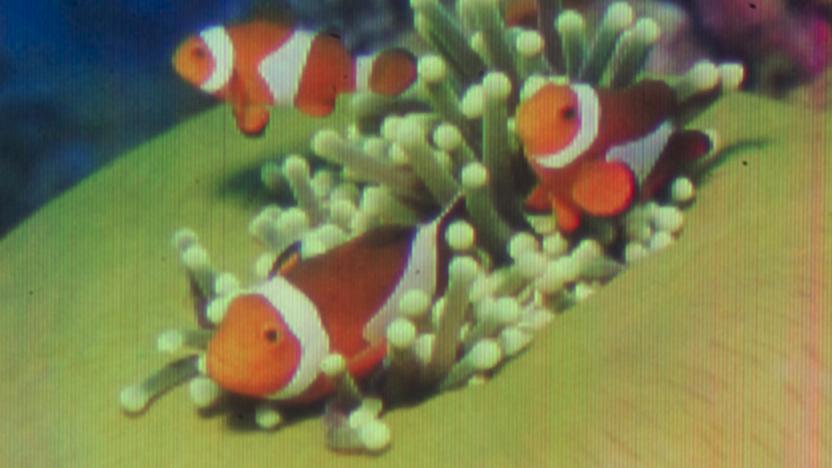
Tiny microscope lets you see the smallest-ever inkjet prints
No, that's not an up-close look at a monitor. That's the world's tiniest color inkjet image made large, and you may not need it blown up to see it in the future -- if you're willing to lay down some cash. In a hybrid of scientific discovery and publicity stunt, Scrona and ETH Zurich have used nano-sized quantum dots to print a clown fish picture measuring just 0.000014 square inches across, setting a Guinness World Record for the smallest color inkjet image to date. You need a good microscope just to see it, in fact... and conveniently, Scrona is working on just that.

4K, quantum dots and more: see the TV technology of CES 2015
Every year at CES, some of the most stunning visuals to be seen come from the TV manufacturers, and 2015 is no exception. Sure, 4K was the name of the game at this year's show, but there were also displays with four times that resolution on offer, too. And while most of the TVs were of the LCD variety, there were stunning sets using OLED and quantum dot tech to deliver better, brighter pictures, too. If you want to see more than just the TVs of CES, check out our 2015 Field Guide.

Yes, LG will have new 4K TVs at CES next week
Ending a long period of speculation, LG revealed that it will have new TVs of the extra-large, super duper high-res variety to show off during CES next week. While that's not really a surprise, one thing we should note is that all of them are flat -- no anti-curved glasses necessary here. Spanning eight different product lines (UC9, UB9800, UF9500, UF9400, UF8500, UF7700, UF6800 and UF6700), LG's Ultra HD TVs have more than just the quantum dot and webOS 2.0 Smart TV updates we've heard about. They're also thinner than ever (of course), with promised upgrades for the color balance and black levels. The embedded 4K video decoder can handle 30fps or 60fps inputs and is "future-proof" for future standards, but we haven't heard specific details about things like expanded color depth.

LG says next year's 4K TVs will be better because of quantum dots
LG has announced that next year, it will have a new set of 4K TVs to slot between its existing Ultra HD LCDs and super-colorful OLED models. These are different because they use quantum dot technology, which LG says will make for a wider color palette and better color saturation than regular LCDs. Sony's already using the technology in its high-end TVs, and reports have indicated that Samsung will offer LCDs with quantum dots as well. The tech used here will use nanocrystals in sizes of 2 to 10 nm that show a different color based on their size, laid in a film over the usual IPS LCD. LG has committed heavily to OLED as a display technology of the future, but even with prices dropping rapidly, it's still out of range for most buyers. As a result, improving traditional LCDs -- and trying to convince folks to upgrade to 4K at all -- is where the key battles will be. The new TVs will be available in 55- and 65-inch versions at first, and you can be sure we'll be taking a close look at them in Las Vegas next month.

3D printing technique will put electronics into just about everything
You can use 3D printing to make a handful of electronics, such as antennas and batteries, but LEDs and semiconductors have been elusive; you usually need some other manufacturing technique to make them work, which limits what they can do and where they'll fit. A team of Princeton researchers recently solved this problem, however. They've found a way to make quantum dot LEDs (and thus semiconductors) using only a 3D printer. The scientists choose printable electrodes, polymers and semiconductors, which are dissolved in solvents to keep them from damaging underlying layers during the printing process; after that, the team uses design software to print the materials in interweaving patterns. In this case, the result is a tiny LED that you could print on to (or into) many objects, including those with curved surfaces.

Tetrapod quantum dot LEDs could lead to cheaper, better HDTVs soon
Until Sony started shipping its Triluminos HDTVs, the future of quantum dot (QD) technology in real-world products was mostly theoretical. Now, a company called Quantum Materials has started shipping its "Tetrapod Quantum Dots" material to an unnamed Asian electronics manufacturer, hinting at the possibility of other QD-enhanced products on the market. The company didn't mention any particular devices, but this tech has the potential to create displays that are brighter, more energy-efficient and have greater contrast than the competition. This technology allows companies to create LED-backlit LCDs using a single material as opposed to several on traditional ones -- this supposedly keeps costs low, although the aforementioned Sony HDTVs were anything but cheap. Quantum Materials CEO Stephen Squires specifically claims his company's tetrapod technology works with fewer dots overall and better manufacturing tech to hit the lowest cost possible. Samsung and LG have shown off quantum dot tech in years past -- we'll eventually find out if either one is the anonymous manufacturer in line to mass produce it.







